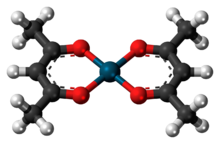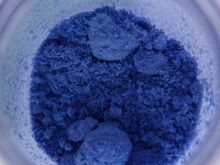Chemistry:Copper(II) acetylacetonate
From HandWiki

| |

| |
| Names | |
|---|---|
| Other names
Bis(2,4-pentanedionato)copper; Cupric acetylacetonate
| |
| Identifiers | |
3D model (JSmol)
|
|
| ChemSpider | |
| EC Number |
|
PubChem CID
|
|
| UNII | |
| |
| |
| Properties | |
| C10H14CuO4 | |
| Molar mass | 261.764 g·mol−1 |
| Appearance | blue solid |
| Density | 0.721 g/cm3 |
| Melting point | 279–283 °C (534–541 °F; 552–556 K) |
Except where otherwise noted, data are given for materials in their standard state (at 25 °C [77 °F], 100 kPa). | |
| Infobox references | |
Copper(II) acetylacetonate is the coordination compound with the formula Cu(O2C5H7)2. It is the homoleptic acetylacetonate complex of copper(II). It is insoluble within water and exists as a bright blue solid. According to X-ray crystallography, the Cu center is square planar.[1] Single crystals of this compound exhibit the unusual property of being highly flexible, allowing the formation of knots. The flexibility is attributed to the nature of the intermolecular forces.[2]
References
- ↑ Vreshch, Volodimir D.; Yang, Jen-Hsien; Zhang, Haitao; Filatov, Alexander S.; Dikarev, Evgeny V. (2010). "Monomeric Square-Planar Cobalt(II) Acetylacetonate: Mystery or Mistake?". Inorg. Chem. 49 (18): 8430–8434. doi:10.1021/ic100963r. PMID 20795642.
- ↑ Aidan J. Brock, Jacob J. Whittaker, Joshua A. Powell, Michael C. Pfrunder, Arnaud Grosjean, Simon Parsons, John C. McMurtrie, Jack K. Clegg (2018). "Elastically Flexible Crystals have Disparate Mechanisms of Molecular Movement Induced by Strain and Heat". Angew. Chem. Int. Ed. 57 (35): 11325–11328. doi:10.1002/anie.201806431. PMID 29998602.
 |

